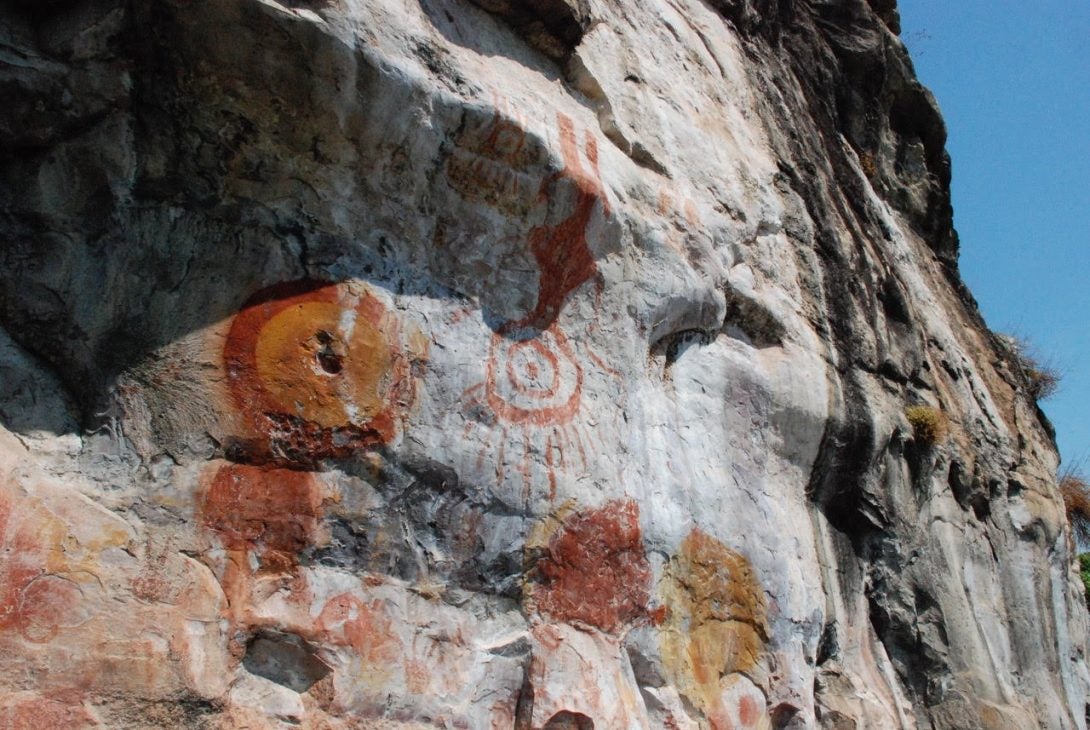Research Unveils Rock Art in Brazil
By Ruth Cherian
Freshman
Biological Sciences
UIC Professor's Rock Art Research Receives Media Attention Heading link

On October 23, 2018, research conducted by anthropologists from the University of Illinois at Chicago (UIC) was featured in a PBS ‘Native America’ documentary. Among the featured anthropologists was Christopher Sean Davis, a Postdoctoral Fellow in Teaching and Mentoring in the Honors College at UIC.
Davis currently teaches four Honors courses: HON 120, Memes through Antiquity: Perception, Propaganda, and Publicity; HON 125, Rise of Civilizations; HON 201, Facts, Truth, Trust and Knowledge; and HON 301, Foundations for the Future.
Davis received a Bachelor of Arts degree in Chemistry at Dartmouth College in New Hampshire. After graduating from Dartmouth College, Davis worked as a chemist. After working for long hours, he often spent the rest of his day watching stimulating documentaries that eventually inspired him to work in the field of anthropology. Davis later pursued and received a Ph.D. in Archaeology from UIC.
Davis’s doctoral research focused on rock art and archaeoastronomy of Paleoindians in Brazil. The motivation behind Davis’s research originated during an excursion to Monte Alegre, a Brazilian city along the Amazon River, with UIC students and UIC professor of anthropology Anna Roosevelt. This excursion exposed Davis to 13,000-year-old rock sites with engraved images. When asked about factors that played a prominent role behind his research, Davis says that his interest in analyzing rock art developed through this visit, but studying astronomy was the hobby which fortunately led him to a great discovery.
When observing various patterns, including constellations and comets, at Serra do Erere, a region within the city of Monte Alegre, Davis did not anticipate that his observations would lead him to discover an ancient astronomical observatory. During his investigation of the 365 patterns which he catalogued and analyzed in around thirty rock shelters, Davis saw how each of these images pointed towards the west, indicating that it was depicted to mark the position of the sun.
“After I started realizing that most of the art was facing the west, which is the direction of the setting sun, some of the images arranged in concentric circles seemed to be representative of the actual setting sun (Halo) which, in most cases, is relatively a rare meteorological phenomenon,” explains Davis, “but once I understood this, then the art became an understanding that they were drawing, for the most part, what they saw. This was an experience that they had at this place that they were trying to preserve and commemorate, record, or track. In my research, I had already come to realize that many tropical cultures pay close attention to constellations as a guide to measure seasonal changes,” Davis adds. “That’s when I started to understand that the rock art, in some of these locations, is an entire year of astronomical constellations that they are marking or filling into this landscape.”
When asked if there were any artifacts left behind, Davis says, “At the main rock art site, we did find a couple of lithics on the surface, but we do not have any context to them. The most significant lithic piece I found was a natural red and purple rock that seemed to be broken off the wall. So they didn’t arbitrarily choose to paint at this particular site, but because the rock itself was colorful it seemed like they were favoring rocks that were colorful [naturally].”
The PBS five-part ‘Native America’ documentary series was directed by Gary Glassman and Providence Pictures. The documentary was filmed in five days during late December in 2016. The anthropologists of UIC were featured in the first episode, ‘From Caves to Cosmos,’ which focused on the roots of Native Americans in North and South America. Davis describes the filming experience as “unique.” Although he dislikes being photographed, he notes how curious he was to learn about the filming process. At the cost of frequently battling heat, scenes were shot during the day to capture the solstice.
Davis has continued his research in Monte Alegre since the discovery and has now set his sights on researching other sites in Brazil, including Pedra Pintada in Roraima, which contains a formation with painted rock art.
As a Postdoctoral Fellow in Teaching and Mentoring for the Honors College, Davis loves the idea of interacting with students. Davis’ involvement with the Honors College has notably influenced him and his work. “I like the idea of interacting with students, as teaching itself helps me to put together all of the information I come across both in research and excavations,” says Davis. “Perhaps, because I’m an anthropologist and I’m interested in basically all things humans do, the interaction with people helps me to connect past with present, information with action, action with emotion, and so, putting all of that together – how people make decisions, seek answers, respond and inspire each other.”